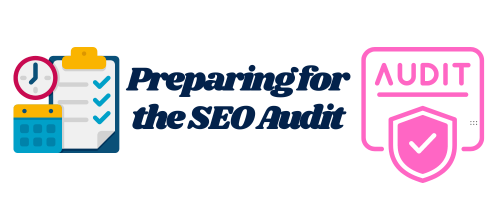An SEO Audit Report is essential for understanding your website’s current performance and identifying opportunities for improvement. This report evaluates various aspects of your site to ensure it meets the latest search engine guidelines and provides the best user experience.
Table of Contents
What is an SEO Audit Report?
An SEO audit report is a comprehensive analysis of your website’s health from a search engine optimization (SEO) perspective. It examines various factors that influence how search engines like Google rank your website, ultimately revealing areas for improvement to boost your online visibility and attract more organic traffic.
Think of it like a checkup for your website. An SEO audit report identifies strengths and weaknesses, allowing you to optimize your site for search engines and ultimately, for your target audience.
Preparing for the SEO Audit
Before diving into the SEO audit, proper preparation is crucial. Here’s what you need to do
Define Objectives: Clearly outline what you aim to achieve with the SEO audit. This could be increasing organic traffic, improving search engine rankings, or enhancing user experience.
Gather Tools: Equip yourself with essential SEO tools such as Google Analytics, Google Search Console, SEMrush, Ahrefs, and Screaming Frog. These tools will help you analyze different aspects of your website.
Backup Your Site: Ensure you have a complete backup of your website. This step is vital to prevent data loss during the audit process.

Benchmark Performance: Note your current key performance indicators (KPIs) like organic traffic, bounce rate, and conversion rate. This will help you measure the impact of the audit later.
Identify Key Pages: List the most important pages of your website. These pages often include your homepage, product pages, and key blog posts.
Check Competitor Sites: Look at competitors’ websites to understand their strengths and weaknesses. This can provide insights into what works well in your industry.
By following these steps, you set a solid foundation for a thorough SEO audit.
Technical SEO Analysis
Technical SEO is the backbone of your website’s performance. Here’s how to ensure your site is technically sound:
Crawlability: Use tools like Screaming Frog to check if search engines can crawl and index your site efficiently. Ensure there are no crawl errors or broken links.
Site Speed: Page load speed is critical for user experience and SEO. Use Google PageSpeed Insights to identify issues slowing down your site and optimize accordingly.
Mobile-Friendliness: With the majority of users accessing websites via mobile devices, ensure your site is fully responsive. Use Google’s Mobile-Friendly Test to check your site’s mobile compatibility.
XML Sitemap: Make sure you have an XML sitemap and it is submitted to Google Search Console. This helps search engines understand the structure of your site and index it more effectively.

Robots.txt: Review your robots.txt file to ensure it is not blocking important pages from being crawled by search engines.
HTTPS: Security is a ranking factor. Ensure your site is using HTTPS instead of HTTP to protect user data and improve trustworthiness.
Structured Data: Implement structured data (schema markup) to help search engines understand your content better and enhance your visibility in search results.
Canonical Tags: Use canonical tags to avoid duplicate content issues and indicate the preferred version of a web page to search engines.
Fix Errors: Regularly check for and fix 404 errors and any other issues reported in Google Search Console.
By addressing these technical SEO aspects, you ensure your website is optimized for both users and search engines.
On-Page SEO Analysis
On-page SEO focuses on optimizing individual pages to rank higher and earn more relevant traffic. Here’s what to examine:
Title Tags: Ensure each page has a unique, descriptive title tag that includes your target keywords. Keep it under 60 characters.
Meta Descriptions: Write compelling meta descriptions for each page, incorporating target keywords. Aim for a length of 150-160 characters.
Headings (H1, H2, H3): Use headings to structure your content. Each page should have one H1 tag with the primary keyword and several H2 and H3 tags to organize subtopics.
Content Quality: Ensure your content is high-quality, relevant, and provides value to the reader. Use target keywords naturally throughout the text without keyword stuffing.
Keyword Usage: Place primary keywords in the first 100 words of your content, and use variations of the keywords throughout the page.
Internal Linking: Use internal links to connect related content on your site. This helps with site navigation and spreads link equity.

Alt Text for Images: Optimize images by using descriptive alt text that includes relevant keywords. This improves accessibility and helps search engines understand the content of your images.
URL Structure: Keep URLs short, descriptive, and keyword-rich. Avoid using unnecessary characters or numbers.
Mobile Optimization: Ensure your on-page elements, such as text and images, are optimized for mobile devices. Content should be easy to read and navigate on smaller screens.
Readability: Use short paragraphs, bullet points, and subheadings to make your content easier to read. Aim for a conversational tone that engages readers.
By focusing on these on-page SEO elements, you can improve your website’s visibility and user engagement.
Off-Page SEO Analysis
Off-page SEO involves activities outside your website that influence your rankings within search engine results pages (SERPs). Here’s what to focus on:
Backlink Profile: Analyze your backlink profile using tools like Ahrefs or Moz. Look for high-quality backlinks from authoritative sites. Disavow any toxic or spammy links.
Social Signals: Monitor social media activity related to your brand. High engagement rates on social platforms can indirectly boost your SEO.
Guest Posting: Identify opportunities for guest posting on reputable websites in your industry. This helps build authority and generates quality backlinks.
Influencer Outreach: Connect with influencers in your niche to promote your content and website. Influencer endorsements can enhance your site’s credibility and attract more traffic.
Online Directories and Listings: Ensure your business is listed accurately on relevant online directories, such as Google My Business, Yelp, and industry-specific directories.
Content Marketing: Develop and promote high-quality content, such as blog posts, infographics, and videos, to attract backlinks and social shares.

Forum and Community Participation: Engage in industry-related forums and communities. Providing valuable insights and linking back to your site can drive traffic and improve your SEO.
Competitor Analysis: Study your competitors’ off-page strategies. Identify where they are getting their backlinks and replicate their successful tactics.
Local SEO: If you have a local business, optimize for local SEO by getting reviews on Google My Business, local citations, and participating in community events.
Press Releases: Distribute press releases for significant news or updates about your business. This can generate buzz and attract backlinks from news sites.
By focusing on these off-page SEO strategies, you can enhance your website’s authority and drive more organic traffic.
User Experience (UX) and Design Analysis
User experience and design play a crucial role in retaining visitors and improving SEO. Here’s what to evaluate:
Navigation: Ensure your website has a clear and intuitive navigation structure. Users should be able to find what they’re looking for with minimal effort.
Layout and Design: Use a clean and professional design that reflects your brand. Avoid cluttered pages and ensure a consistent layout across all pages.
Mobile Usability: Test your website on various devices and screen sizes. Ensure that all elements, such as buttons and links, are easily clickable on mobile devices.
Page Speed: Optimize images, leverage browser caching, and minimize CSS and JavaScript to improve page load times. Faster pages enhance user satisfaction and reduce bounce rates.
Accessibility: Make your site accessible to all users, including those with disabilities. Use descriptive alt text for images, provide captions for videos, and ensure your site is navigable via keyboard.
Content Readability: Use legible fonts, adequate spacing, and contrasting colors to make your content easy to read. Break up text with headings, bullet points, and images.

Call-to-Action (CTA): Place clear and compelling CTAs throughout your site. Ensure they stand out visually and encourage users to take desired actions, such as signing up for a newsletter or making a purchase.
User Feedback: Collect feedback from users to identify pain points and areas for improvement. Use surveys, feedback forms, and usability testing to gather insights.
Engagement Metrics: Monitor metrics such as bounce rate, average session duration, and pages per session. High engagement metrics indicate a positive user experience.
Security: Ensure your site is secure by using HTTPS, implementing regular security updates, and protecting against malware. A secure site builds trust with users and search engines.
By focusing on these UX and design elements, you can create a website that not only ranks well but also provides a satisfying experience for visitors.
Competitive Analysis
Understanding your competition is vital for developing an effective SEO strategy. Here’s how to conduct a thorough competitive analysis:
Identify Competitors: Determine who your main competitors are by searching your primary keywords and noting which websites appear in the top positions.
Analyze Their Content: Examine the type of content your competitors are producing. Identify their top-performing pages, content length, and the topics they cover.
Keyword Analysis: Use tools like SEMrush or Ahrefs to find out which keywords your competitors are ranking for. Look for keyword gaps—opportunities where you can rank higher for specific terms they may have overlooked.
Backlink Profile: Investigate your competitors’ backlink profiles to understand where their links are coming from. Identify high-authority sites linking to them and consider how you can earn similar backlinks.
Social Media Presence: Assess your competitors’ social media activity. Look at the platforms they are active on, the type of content they share, and their engagement levels. Learn from their successes and avoid their mistakes.

Technical SEO: Compare your competitors’ technical SEO aspects, such as site speed, mobile-friendliness, and overall user experience. Identify areas where your site can outperform theirs.
User Experience (UX): Evaluate the user experience on your competitors’ websites. Take note of their design, navigation, and overall ease of use. Aim to provide a superior user experience on your site.
Paid Advertising: If your competitors are using paid advertising, analyze their ad strategies. Look at their ad copy, keywords, and landing pages to understand what is driving their traffic and conversions.
Local SEO: For local businesses, examine your competitors’ local SEO efforts. Check their listings on Google My Business, local directories, and customer reviews. Strive to get more positive reviews and improve your local presence.
Content Strategy: Identify the content formats your competitors use effectively, such as blogs, videos, infographics, or podcasts. Incorporate similar formats into your content strategy where relevant.
By conducting a comprehensive competitive analysis, you can gain valuable insights to refine your SEO strategy and outperform your competition.
Reporting and Recommendations
After completing your SEO audit, compiling the findings into a detailed report is essential. Here’s how to structure your report and provide actionable recommendations:
Executive Summary: Start with a brief overview of the audit’s key findings and the primary areas that need attention. Highlight the main opportunities for improvement.
Technical SEO Findings: Summarize the results of the technical SEO analysis. Include details on crawlability issues, site speed, mobile-friendliness, XML sitemap status, robots.txt, HTTPS implementation, structured data, and canonical tags.
On-Page SEO Findings: Provide insights from the on-page SEO analysis. Cover title tags, meta descriptions, headings, content quality, keyword usage, internal linking, alt text for images, URL structure, mobile optimization, and readability.
Off-Page SEO Findings: Detail the results of the off-page SEO analysis. Discuss your backlink profile, social signals, guest posting opportunities, influencer outreach, online directories, content marketing efforts, forum participation, competitor strategies, local SEO, and press releases.

User Experience (UX) and Design Findings: Share the findings from the UX and design analysis. Address navigation, layout and design, mobile usability, page speed, accessibility, content readability, CTAs, user feedback, engagement metrics, and site security.
Competitive Analysis Findings: Present the insights from your competitive analysis. Compare your site with competitors in terms of content, keywords, backlinks, social media presence, technical SEO, UX, paid advertising, and local SEO efforts.
Actionable Recommendations: Provide clear and specific recommendations based on your findings. Prioritize the actions by their potential impact and ease of implementation. For example:
- Fix crawl errors and improve site speed.
- Optimize title tags and meta descriptions with target keywords.
- Enhance mobile usability and ensure a responsive design.
- Build high-quality backlinks and disavow toxic links.
- Improve content quality and focus on keyword gaps.
Timeline and Resources: Suggest a timeline for implementing the recommendations and outline the resources needed, such as tools, budget, and personnel.
Performance Metrics: Define the KPIs to track the progress of the implemented changes. These could include organic traffic, keyword rankings, bounce rate, conversion rate, and backlink growth.
Next Steps: Conclude with a clear plan of action. Assign responsibilities, set deadlines, and schedule follow-up audits to monitor the improvements.
By structuring your report in this way, you provide a comprehensive overview of your website’s current SEO status and a clear roadmap for future enhancements.
Conclusion
An SEO audit report is a vital tool for understanding your website’s performance and identifying areas for improvement. By systematically analyzing technical SEO, on-page and off-page elements, user experience, and competitive landscape, you can create a strategic plan to enhance your site’s visibility and effectiveness.
Implementing the recommendations from the audit will help boost your search engine rankings, attract more organic traffic, and ultimately achieve your business goals. Regular audits are essential to stay ahead in the constantly evolving SEO landscape and to ensure that your website continues to perform at its best.
By following the steps outlined in this guide, you can conduct a thorough SEO audit and make informed decisions to optimize your website for both users and search engines.






